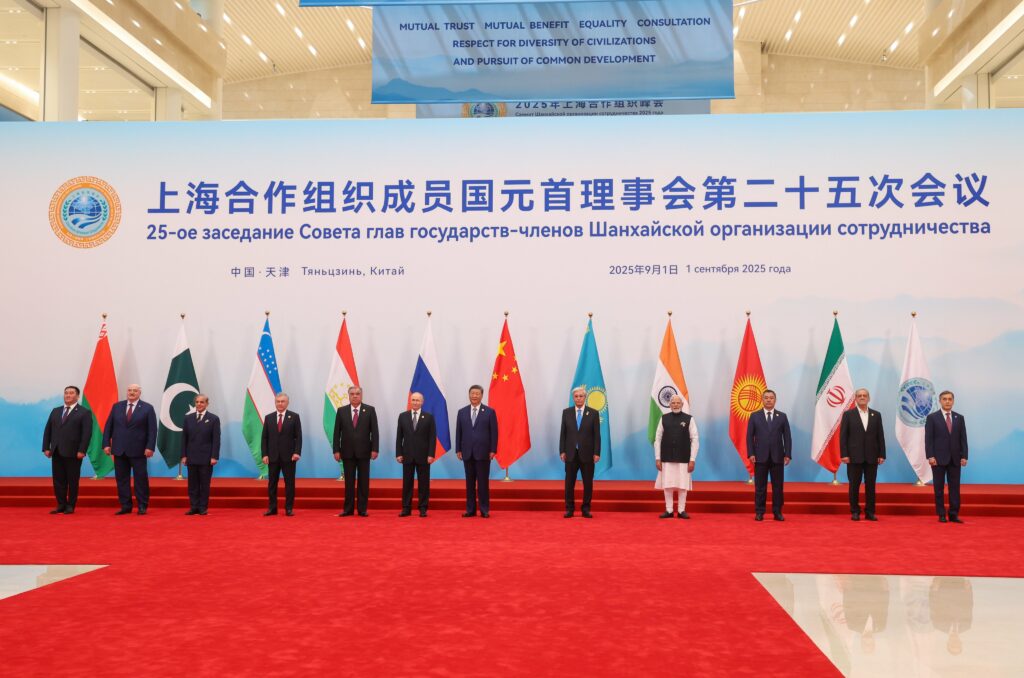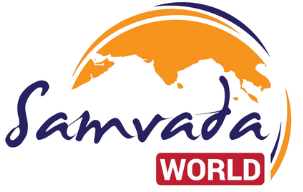
- The 2025 SCO Summit in Tianjin, China, is especially notable given the current rise in global tensions. It comes at a moment when tariffs, great power competition, and regional realignments are reshaping the world order.
- The new wave of tariffs by the Trump administration, with duties of up to 50% on Indian exports, has shaken Asian economies. These measures have accelerated the SCO’s push for de-dollarisation and internal economic resilience.
- With Iran as a full member, the SCO finally has access to the Persian Gulf and greater leverage in the energy geopolitics of the world. Tehran views this as an insurance policy against Western sanctions and isolation.
- The 2025 Tianjin Summit is not just a standard diplomatic meeting; it is a geopolitical announcement. It signals the consolidation of multipolarity as a current reality rather than a prospect.
The world is undergoing a profound geopolitical realignment. The ebb of the U.S.-led unipolar era and the rise of rival centres of power have brought into being a new era of multipolarity. At the centre of this change is the Shanghai Cooperation Organisation (SCO), which has gradually matured from a modest regional security alliance to one of the globe’s preeminent multilateral forums.
The 2025 SCO Summit in Tianjin, China, is especially notable given the current rise in global tensions. The renewed tariffs of the Trump administration are upending international commerce, Russia has expanded its engagement with the Taliban authorities in Afghanistan and the U.S.-China competition continues unabated. In this context, the SCO presents an alternative vision for regional and global governance, one that centres on sovereignty, non-interference, and collective security, distinct from Western systems.
This article examines the main themes, challenges, and opportunities of the Tianjin summit, assessing its implications for Asia, global trade, and the wider world order.
The Evolution of the SCO: From Security Club to Geopolitical Bloc
Established in 2001, the SCO united China, Russia, Kazakhstan, Kyrgyzstan, Tajikistan and Uzbekistan, mainly to deal with border conflicts, terror, and security issues in the region. It later broadened its membership to incorporate India, Pakistan, and Iran and took in a few observer nations such as Afghanistan, Belarus, and Mongolia. Now, the SCO comprises more than 40% of the world’s population and nearly a third of global economic output, a massive bloc by anyone’s standards.
The SCO agenda has expanded considerably. It started as a regional security arrangement, evolved into a geopolitical and geoeconomic coalition, and now has cooperation on infrastructure, trade, energy, digital governance, and counterterrorism. Notably, it is a countervailing force to Western-dominated organisations like NATO, the EU, and the G7.
The Tianjin summit is a watershed moment in this path, a testament to how far the SCO has travelled toward affirming its position in remaking global governance.
Why Tianjin Matters: The Geopolitical Context
The location and timing of the 2025 summit are significant. China, which is hosting the port city of Tianjin, aims to emphasise its position as the architect of Asian multilateralism. The summit takes place in the midst of five overlapping geopolitical trends:
U.S. Trade Tariffs and Economic Uncertainty
The new wave of tariffs by the Trump administration, with duties of up to 50% on Indian exports, has shaken Asian economies. The SCO is becoming more seen as a platform for de-dollarisation of trade, lowering reliance on Western markets, and bolstering internal economic resilience.
Russia’s Afghanistan Gambit
Moscow’s expanded engagement with the Taliban authorities has added a new regional factor. Afghanistan, a SCO observer state, might now acquire more legitimacy within the group, reorganising Central Asian security and connectivity.
China–India Relations
Prime Minister Modi’s visit to China, the first in more than seven years, is a sign of a cautious approach. Border conflicts are still unresolved, but economic pragmatism and the appeal of multipolar engagement drive both countries toward talks.
Iran’s Strategic Role
With Iran as a full member, the SCO finally has access to the Persian Gulf and greater leverage in the energy geopolitics of the world. Tehran sees the organisation as an insurance policy against Western sanctions and isolation.
The Multipolar Narrative
The summit gives Beijing and Moscow the chance to present the SCO as the paradigm institution of multipolarity, as a way to replace the Western “rules-based” order.
Now, the SCO comprises more than 40% of the world's population and nearly a third of global economic output, a massive bloc by anyone's standards. This scale gives the organisation significant weight in shaping both Eurasian and global governance.
Key Themes at the Tianjin Summit
- Security and Counterterrorism
Security is the SCO’s core agenda. With the resurgence of extremist forces in Afghanistan and Pakistan and the spectre of cyberterrorism, the SCO will likely strengthen its Regional Anti-Terrorist Structure (RATS). Russia and China are anxious to present the bloc as the bastion of Eurasian security, especially in a post-U.S. Afghanistan. - Trade and Economic Cooperation
The theme of economic resilience dominates this year. Members are called on to further apply local currencies to trade, expand upon China’s Belt and Road Initiative (BRI), and further integrate supply chains. India, cautious about BRI, is exploring ways to use SCO trade corridors to recover tariff losses in U.S. markets. - Energy Politics
With Russia, Iran, and the Central Asian states possessing enormous hydrocarbon reserves, energy cooperation is at the centre. The creation of an SCO Energy Club is under consideration, which would harmonise oil and gas policies as well as speed up energy transition projects in Eurasia. - Digital Sovereignty and Governance of AI
China is actively promoting increased cooperation on digital infrastructure and governance of emerging technologies such as AI. As AI is increasingly viewed as a strategic tool, the SCO is likely to be a group championing non-Western standards in digital sovereignty, cybersecurity, and cross-border data regulation. - Connectivity and Infrastructure
Initiatives such as the China–Pakistan Economic Corridor (CPEC), the India, Russia, and Iran-led International North–South Transport Corridor (INSTC), and the Trans-Caspian routes reflect the SCO’s position as a unifier of Eurasian infrastructure.
India’s Balancing Act: Between Washington and Tianjin
For India, the Tianjin summit is a chance and an experiment. On the one hand, the SCO is an opportunity to draw in China and Russia within a multipolar matrix and enlarge access to Central Asian energy and trade routes. On the other hand, U.S. tariffs risk catapulting New Delhi into a defensive strategy economically and weakening the U.S.–India strategic alliance.
India’s agenda in Tianjin is likely to include:
- Securing energy partnerships with Russia and Iran to stabilise the domestic supply.
- Expanding trade networks within Asia to reduce reliance on U.S. markets.
- Positioning itself as a bridge between Western institutions and Eurasian blocs.
New Delhi’s challenge is maintaining strategic autonomy without appearing either fully aligned with Washington or overly dependent on Beijing and Moscow.
China’s Vision: SCO as the Asian Century’s Vehicle
For Beijing, the summit in Tianjin is symbolic. It makes China the hub of Asian multilateralism, able to mould institutions that can rival their Western counterparts. There are three aspects to China’s approach:
- Economic Leverage – Enlarge Belt and Road initiatives under the SCO umbrella, marrying supply chains from Central Asia to South Asia.
- Security Leadership – Become a stabiliser in Afghanistan and Central Asia and diminish Western influence.
- Normative Power – Encourage “Shanghai Spirit” values of sovereignty and non-interference as counterpoints to Western liberal interventionism.
Russia’s Agenda: From Isolation to Centrality
Confronted with long-term Western sanctions and economic isolation, Moscow sees the SCO as a diplomatic lifeline. By engaging more closely with Iran and Afghanistan, Russia seeks to reposition itself in Eurasian geopolitics. Energy exports, arms sales, and security coordination provide Moscow with considerable clout within the bloc.
The Tianjin summit enables Russia to project itself not as a pariah, but as a leading drafter of multipolarity.
The Challenges Ahead
Even with aspirations, the SCO is confronted with several structural challenges:
- India–China Rivalry: Border conflicts and geopolitical rivalry pose threats to cohesion from within.
- Asymmetric Economies: Dominance by China’s economy eclipses smaller members, causing fears of over-reliance.
- Divergent Interests: Russia emphasises security, India emphasises trade, and China emphasises infrastructure—aligning these disparate agendas is complicated.
- Western Pushback: The U.S. and its allies will probably react with counter-coalitions, technology controls, and intensified partnerships within the Indo-Pacific.
The Multipolar Future: SCO’s Global Implications
The SCO’s development mirrors the general decline of the U.S.-led unipolarity. In trade, technology, and security, the organisation is increasingly emerging as the institutional scaffolding of multipolar Eurasia.
- For Asia, it holds out the prospect of increased regional integration and resilience.
- For the West, it marks the emergence of a systemic challenger to liberal internationalism.
- For the world, it demonstrates that multipolarity is not a prospect; it is a current reality.
The 2025 Tianjin Summit is not just a standard diplomatic meeting; it is a geopolitical announcement. It demonstrates how China, Russia, India, Iran, and other Eurasian players are cooperating to build an alternative world order, based on multipolarity, sovereignty, and regional integration.
But the way ahead is through divisions within, as well as resistance from, outside. The success of the SCO will ultimately rest on the extent to which it can reconcile conflicting interests while delivering tangible benefits for its membership.
In a sense, the summit captures the organising question of our time: Can the multipolar order be managed collectively, or will it heighten world fragmentation? For the present, Tianjin announces that the era of multipolarity is not only on the move, it is gaining momentum.
References:
- Al Jazeera. (2025, August 30). SCO summit in China: Who’s attending, what’s at stake amid Trump tariffs? Retrieved from https://www.aljazeera.com/news/2025/8/30/sco-summit-in-china-whos-attending-whats-at-stake-amid-trump-tariffs
- AP News. (2025, August 31). The Shanghai Cooperation Organization summit challenges the US, but its reach is murky. Retrieved from https://apnews.com/article/37d58d94f70814c8e7a23721997abc2b
- New Indian Express. (2025, August 30). Modi-Xi talks to focus on long-term stability, trade cooperation. Retrieved from https://www.newindianexpress.com/nation/2025/Aug/30/modi-xi-talks-to-focus-on-long-term-stability-trade-cooperation
- Reuters. (2025, August 27). India and, US to lose from Trump tariffs as Russia wins. Retrieved from https://www.reuters.com/markets/commodities/india-us-lose-trump-tariffs-russia-wins-2025-08-27
- South Asian Voices. (2025, August 29). Russia’s recognition of the Taliban: Geopolitical shifts in Central Asia. Retrieved from https://southasianvoices.org/geo-f-in-n-russia-recognition-taliban-08-29-2025

Raghvendra Tripathi is an independent researcher with a background in computer applications and a keen interest in technology and geopolitics. His articles focus on how emerging technologies influence international strategy, policy, and global power dynamics. Views expressed are the author’s own.
